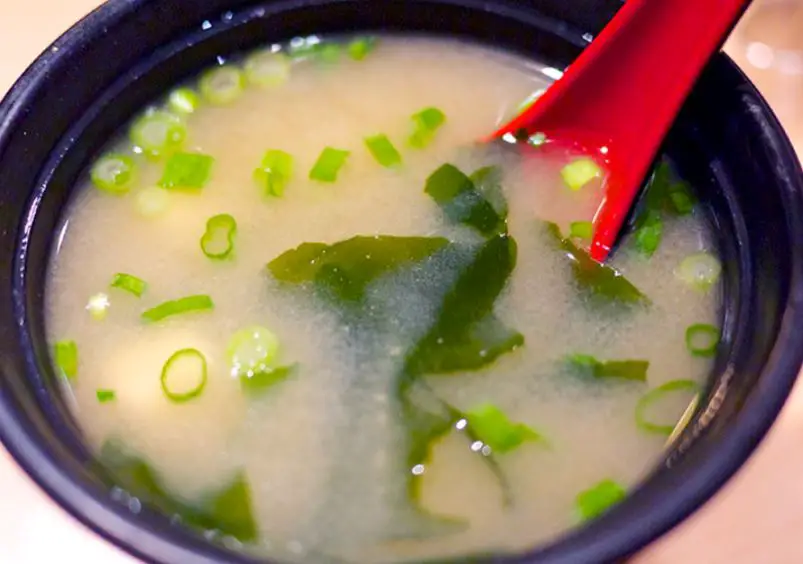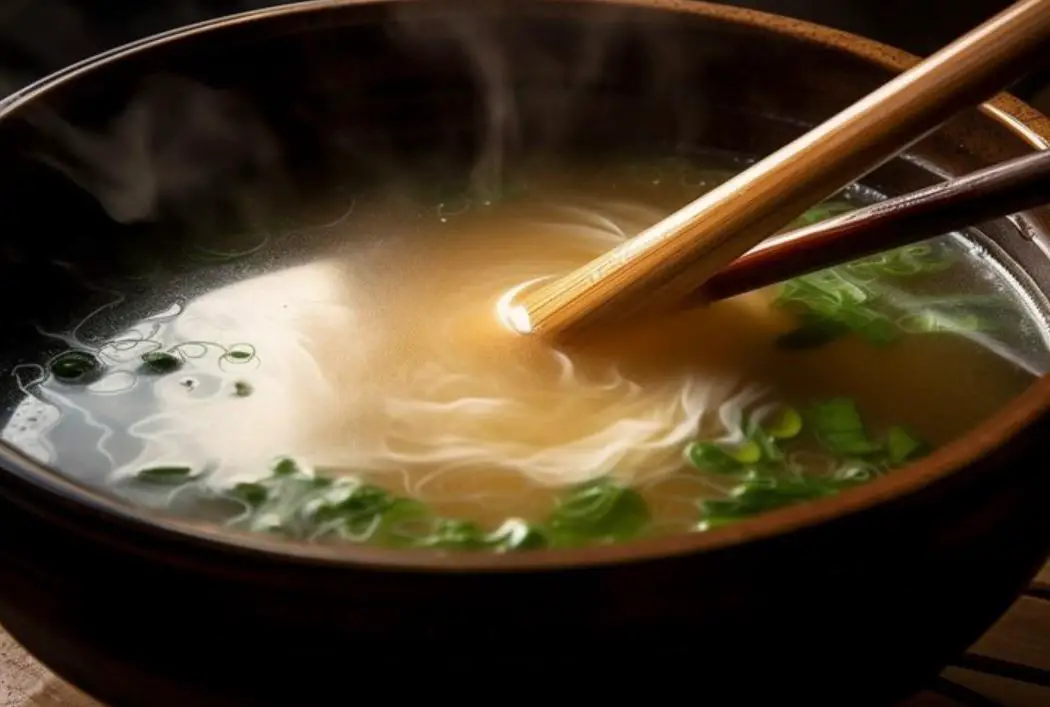Miso Soup, a cornerstone of Japanese cuisine, is a savory, traditional broth revered for its simple yet profound flavors. This comforting soup, typically made with a base of miso paste and dashi, embodies a harmonious blend of umami and warmth. It’s a versatile dish, often enriched with ingredients like tofu, seaweed, and green onions, reflecting the essence of Japanese culinary simplicity and elegance.
What is Miso Soup
Miso soup is a traditional Japanese soup that forms an integral part of the Japanese diet. It’s known for its unique taste and numerous health benefits. The soup’s base is made from miso paste, which is produced by fermenting soybeans with salt and a fungus known as koji. The fermentation process can vary, resulting in different types of miso paste, such as white, red, or mixed, each offering a distinct flavor profile.
The other key component of miso soup is dashi, a broth typically made from kombu (dried kelp) and bonito fish flakes. Dashi provides a savory umami flavor that complements the miso paste. Together, these ingredients create a rich, complex broth that is both savory and slightly salty, with a depth of flavor that is uniquely satisfying.
Miso soup is often customized with a variety of ingredients, such as tofu, seaweed (wakame), green onions, and sometimes vegetables like mushrooms or radish. These additions not only enhance the flavor and texture of the soup but also contribute additional nutritional benefits.
Nutritionally, miso soup is revered for its health-promoting properties. Miso paste is rich in essential minerals and a good source of various B vitamins, vitamin E, vitamin K, and folic acid. Being a fermented food, miso also contains beneficial bacteria that promote gut health. The soup is generally low in calories, yet it’s quite filling, making it a popular choice for those seeking a nutritious and comforting meal.
In Japanese culture, miso soup is more than just a food item; it’s a part of daily life, often consumed with meals, particularly breakfast. Its warming and comforting qualities make it a beloved dish, enjoyed for both its taste and its health benefits.
Is Miso Soup Gluten Free
When considering the gluten content in miso soup, it’s essential to delve into the ingredients used in its preparation. Miso paste, the primary component, is traditionally made from fermented soybeans, salt, and koji (a type of fungus). While pure soybeans are gluten-free, the concern for gluten arises depending on the grains used in the fermentation process. Some miso pastes incorporate barley or wheat, which are gluten-containing grains. Therefore, it’s crucial for those with gluten sensitivities or celiac disease to carefully examine the type of miso used.
Exploring Gluten Content in Miso Soup
Dashi, the other key ingredient in miso soup, is typically gluten-free, being made from seaweed (kombu) and bonito fish flakes. However, caution is advised as some pre-packaged dashi might contain added flavors or ingredients that include gluten.
For those seeking a gluten-free version of miso soup, the solution lies in selecting miso paste made exclusively from rice or soybeans, ensuring no wheat or barley is involved. Additionally, preparing dashi from scratch or choosing a certified gluten-free option can further guarantee a gluten-free experience.
In conclusion, while traditional miso soup can contain gluten depending on the ingredients used, with careful selection and attention to detail, it is entirely possible to enjoy a delicious, gluten-free version of this classic Japanese dish.
Is Miso Soup Healthy
Miso soup, a staple in Japanese cuisine, is not only cherished for its taste but also for its numerous health benefits. The primary ingredient, miso paste, is a powerhouse of nutrition. Made from fermented soybeans, it is rich in essential minerals like zinc, copper, and manganese, and provides a good source of various B vitamins. The fermentation process also fosters the growth of probiotics, beneficial bacteria that support gut health, aiding in digestion and absorption of nutrients.
Unveiling the Health Benefits of Miso Soup
The other key component, dashi, is low in calories and rich in minerals extracted from its seaweed and fish ingredients. It’s an excellent source of iodine, crucial for thyroid function, and contains small amounts of magnesium and calcium.
Miso soup often includes tofu, a great source of plant-based protein, and seaweed, which is high in vitamins A and C, as well as calcium and magnesium. These additions not only enhance the flavor profile but also contribute to the overall nutritional value of the soup.
Regular consumption of miso soup has been associated with various health benefits, including improved digestion and gut health, a stronger immune system, and potentially reduced risk of certain diseases. Its high antioxidant content helps in combating oxidative stress, thereby promoting overall health.
However, it’s important to note that miso soup can be high in sodium, which should be considered, especially for those with hypertension or heart disease. Moderation is key, and as part of a balanced diet, miso soup can be a healthful and nourishing choice.
Is Miso Soup Vegan
Miso soup, a traditional Japanese dish, raises questions about its compatibility with a vegan diet. The basic ingredients of miso soup are miso paste, made from fermented soybeans, and dashi, a Japanese stock. While miso paste is inherently vegan, being a product of soybeans, salt, and koji culture, the traditional dashi stock poses a challenge for vegans.
Assessing the Vegan Status of Miso Soup
Classic dashi is typically made using bonito flakes (dried and smoked fish), which is not suitable for a vegan diet. However, there is an alternative known as kombu dashi, made exclusively from kombu (edible kelp), which is entirely plant-based and vegan-friendly.
The adaptability of miso soup is one of its strengths, allowing for the creation of a completely vegan version. By using kombu dashi or other plant-based broths, and ensuring that the miso paste is free from any non-vegan additives, one can easily prepare a vegan miso soup. Common additions to miso soup, such as tofu, seaweed, and vegetables like green onions, mushrooms, and carrots, align well with vegan dietary preferences.
In summary, while traditional miso soup with bonito-based dashi is not vegan, the dish can be effortlessly modified to fit a vegan diet by using kombu dashi or other vegan-friendly stock options. This flexibility makes miso soup a versatile and inclusive dish that can be enjoyed by people following various dietary lifestyles.
How Many Calories in Miso Soup
Miso soup, known for its light yet flavorful profile, is often considered a low-calorie option in the realm of soups. The caloric content of miso soup can vary depending on the specific ingredients and their quantities used in the recipe. However, a standard serving of miso soup, which typically includes a broth made from miso paste and dashi, along with additions like tofu, seaweed, and green onions, generally contains between 35 to 60 calories per serving.
Analyzing the Caloric Content of Miso Soup
The majority of the calories in miso soup come from the miso paste itself. Miso, being a fermented soybean product, is relatively low in calories but dense in nutrients. A tablespoon of miso paste, which is roughly what’s used in one serving of soup, contains about 25 to 30 calories.
Additions to the soup, such as tofu and vegetables, contribute minimally to the overall caloric count. For instance, a small amount of tofu can add around 20 calories, while vegetables like seaweed and green onions add a negligible amount.
It’s important to note that these figures can vary. Commercially prepared miso soups, especially those in restaurants or instant varieties, may have higher calorie counts due to larger serving sizes or added ingredients like oils or sugars.
In conclusion, miso soup is a low-calorie option, making it a favorable choice for those monitoring their calorie intake. Its light nature, coupled with the nutritional benefits of its ingredients, makes it a healthy and satisfying choice for a variety of dietary needs.

Is Miso Soup Keto
When assessing whether miso soup is suitable for a ketogenic diet, it’s important to consider the carbohydrate content of the ingredients. The ketogenic diet is characterized by low carbohydrate and high fat intake, aiming to induce a state of ketosis in the body.
Miso paste, the primary ingredient in miso soup, is relatively low in carbohydrates. A tablespoon of miso paste typically contains about 2 to 3 grams of net carbs. This low carb count makes it a potentially suitable option for those following a keto diet.
Evaluating Miso Soup for a Keto Diet
Dashi, the other main component of miso soup, is virtually carb-free, especially if made traditionally with kombu and bonito flakes. However, it’s important to be cautious with instant dashi or flavored varieties, as they may contain added sugars or carbohydrates.
Common additions to miso soup, such as tofu, are also keto-friendly. Tofu is low in carbs and high in protein, aligning well with keto dietary requirements. However, one should be mindful of the quantity, as carbs can add up.
Seaweed, another frequent ingredient in miso soup, is low in carbs and can be included in a keto diet. However, other common ingredients like carrots or potatoes should be avoided or used sparingly, as they are higher in carbs.
In summary, traditional miso soup, especially when prepared with careful consideration of the ingredients and their quantities, can be adapted to fit a ketogenic diet. It’s a matter of ensuring that the carb content of the soup aligns with the strict carb limits of the keto diet, which typically restricts net carb intake to about 20-50 grams per day.
How Long Does Miso Soup Last
The longevity of miso soup, like any food item, depends on how it is stored. When stored properly, miso soup can maintain its quality and safety for consumption for a certain duration.
Understanding the Shelf Life of Miso Soup
Refrigeration:
When kept in the refrigerator, miso soup can last for about 2 to 5 days. It’s important to store the soup in an airtight container to prevent it from absorbing other flavors and odors from the fridge. The cooler temperature slows down the growth of bacteria, helping to preserve the soup for a few days.
Freezing:
Miso soup can be frozen for extended shelf life. In the freezer, it can last for up to one month. However, it’s worth noting that the texture of some ingredients, like tofu and some vegetables, may change after freezing and thawing. To freeze miso soup, let it cool completely before transferring it to a freezer-safe container or bag.
Room Temperature:
It is not advisable to leave miso soup at room temperature for more than 2 hours. Bacteria grow rapidly at temperatures between 40°F and 140°F, and miso soup left out for more than 2 hours at room temperature should be discarded.
Reheating:
When reheating refrigerated or thawed miso soup, ensure it reaches a temperature of 165°F to kill any potential bacteria. It’s best to reheat only the amount you plan to consume immediately.
Preparation and Freshness:
The shelf life of miso soup also depends on the freshness of the ingredients used and how it was prepared. Freshly made miso soup with high-quality ingredients will last longer and taste better, even after storage.
In conclusion, proper storage is key to extending the shelf life of miso soup. Refrigeration is suitable for short-term storage, while freezing is an option for keeping the soup for a longer period. Always practice food safety by monitoring storage times and temperatures.

What Does Miso Soup Taste Like
Miso soup, a staple in Japanese cuisine, offers a unique and complex flavor profile that is both comforting and distinctive. The taste of miso soup is primarily influenced by its two main ingredients: miso paste and dashi.
Exploring the Flavor Profile of Miso Soup
Umami Richness:
The most prominent taste in miso soup is umami, often described as a savory or meaty flavor. Miso paste, made from fermented soybeans, is naturally rich in glutamates, which are compounds that contribute to the umami taste. This deep, savory flavor is the backbone of miso soup’s taste.
Salty and Slightly Sweet:
Miso paste also brings a balanced saltiness to the soup, with a subtle underlying sweetness. The degree of saltiness and sweetness can vary depending on the type of miso used. White miso tends to be milder and sweeter, while red miso offers a stronger, saltier flavor.
Complexity from Dashi:
Dashi, the other key component, is a broth typically made from kombu (dried kelp) and bonito flakes (dried fish), which adds another layer of umami along with a slight oceanic essence. The dashi complements the miso and rounds out the flavor, adding depth and complexity.
Texture and Additional Flavors:
Common additions to miso soup, such as tofu, seaweed, and green onions, contribute to its overall taste and texture. Tofu adds a soft, creamy element, seaweed introduces a slight brininess, and green onions provide a fresh, mild sharpness.
Warm and Comforting:
Overall, miso soup is often described as warm, comforting, and soul-satisfying. Its flavor is not overpowering but rather subtle and nuanced, with each sip offering a harmonious blend of savory, salty, and a touch of sweetness.
In summary, miso soup’s taste is a delightful amalgamation of umami richness, balanced saltiness, subtle sweetness, and a depth of flavor provided by dashi. Its comforting and soothing nature makes it a beloved dish in Japanese cuisine and beyond.
Is Miso Soup Good for You
Miso soup, a traditional Japanese dish, is not only popular for its taste but also for its nutritional benefits, making it a healthful addition to many diets.
Assessing the Health Benefits of Miso Soup
Rich in Nutrients:
Miso, the primary ingredient in miso soup, is made from fermented soybeans and is rich in various vitamins and minerals. It contains B vitamins, vitamin E, vitamin K, and essential minerals like zinc, copper, and manganese. The fermentation process also enhances its nutritional profile, making these nutrients more easily absorbable.
Probiotic Properties:
The fermentation process that miso undergoes results in the presence of beneficial bacteria, known as probiotics. These probiotics can help promote a healthy gut microbiome, aiding in digestion and potentially improving gut health.
Heart Health:
Some studies suggest that regular consumption of miso soup may be associated with a reduced risk of cardiovascular diseases. This is attributed to the presence of isoflavones in soybeans, which are thought to have heart-protective properties.
Low in Calories:
Miso soup is generally low in calories, making it a good choice for those who are watching their calorie intake. The exact calorie count can vary depending on the ingredients added, such as tofu, seaweed, and vegetables.
Sodium Content:
One aspect to be mindful of is the sodium content in miso soup. Miso is high in salt, which can contribute to increased blood pressure and heart health issues if consumed in large amounts. It’s advisable to consume miso soup in moderation, especially for individuals with hypertension or a need to monitor their sodium intake.
Antioxidant Properties:
Miso contains antioxidants, which help combat oxidative stress in the body, potentially reducing the risk of chronic diseases and promoting overall health.
Bone Health:
The isoflavones in miso have also been linked to improved bone health, potentially reducing the risk of osteoporosis, particularly in postmenopausal women.
In conclusion, miso soup can be a healthful addition to your diet, offering a range of nutrients, probiotics, and potential health benefits. However, due to its high sodium content, it should be consumed in moderation, especially by those with specific health concerns related to sodium intake.

How to Make Miso Soup from Paste
Simple and Traditional Miso Soup Recipe
Ingredients:
- 4 cups of water
- 2 teaspoons of dashi granules (or homemade dashi)
- 3 tablespoons of miso paste (white or red, depending on preference)
- 1 block of silken tofu, cut into small cubes
- 1 sheet of nori (dried seaweed), cut into thin strips
- 2 green onions, finely chopped
- Optional: 1/2 cup of sliced mushrooms or a small handful of wakame seaweed
Instructions:
- Prepare the Dashi: In a medium-sized pot, bring the 4 cups of water to a boil. Reduce the heat to low and add the dashi granules. Stir until the granules are completely dissolved. If you’re using homemade dashi, heat it to a simmer.
- Add Tofu and Optional Ingredients: Add the cubed tofu to the dashi. If you’re using mushrooms or wakame seaweed, add them at this stage. Simmer these ingredients for about 2 minutes, allowing them to cook gently.
- Dissolve the Miso Paste: In a small bowl, take a ladleful of the hot dashi and dissolve the miso paste in it. It’s important to dissolve the miso paste separately to prevent clumping and to preserve its flavor and health benefits.
- Combine Miso with Dashi: Turn off the heat under the pot. Add the dissolved miso mixture back into the pot and stir gently to combine. It’s crucial not to boil the soup after adding the miso, as high heat can destroy the beneficial probiotics in the miso.
- Add Nori and Green Onions: Add the nori strips and green onions to the soup. Let them sit in the hot soup for a minute to soften slightly.
- Serve Immediately: Serve the miso soup hot. It’s best enjoyed fresh, as the flavors and nutrients are most potent when freshly prepared.
Tips:
- Adjust the amount of miso paste according to your taste preference. More miso paste will result in a stronger, saltier soup.
- Be mindful of the sodium content in miso paste and dashi, especially if you’re watching your salt intake.
- You can add other vegetables like spinach or bok choy for a variation.
- Remember, miso soup is versatile, so feel free to experiment with different ingredients!
Enjoy your homemade, comforting bowl of miso soup!
Conclusion: Understanding Miso Soup
Miso soup, a staple of Japanese cuisine, is much more than a simple broth. It’s a symphony of flavors and a testament to the culinary philosophy of Japan, where the quality and natural taste of ingredients are celebrated. At its heart, miso soup combines the rich, savory flavors of miso paste with the depth and complexity of dashi broth. This combination creates a soup that is not only delicious but also packed with nutritional benefits, from the probiotics in miso to the minerals in dashi.


